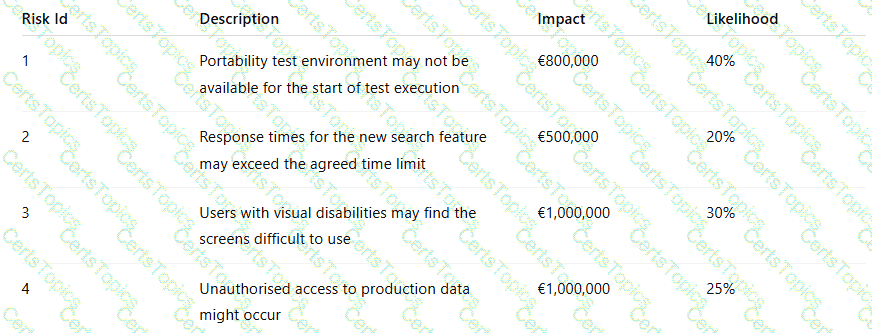SoftTech provides a core banking product to retail banks to enable their customers to process payments via the Internet and telephone banking and. as SoftTech's Test Manager, you are responsible for system testing and system integration testing of all SoftTech's products.
Your current project is to integrate SoftTech's core banking product with an existing bank's systems, which are maintained by experienced developers but poorly
documented.
A specification for the 10 interfaces to the bank's existing systems has been produced by SoftTech's development team. There is an estimating matrix for system integration testing that allows 2 man days per interface for preparation, plus 2 man days per interface for test execution. The exit criteria for the completion of system integration testing has been agreed as:
1. No open Severity 1 defects
2 No more than 10 open severity 2 and/or 3 defects
3. All interfaces tested
4. Cost estimate must not be exceeded
System integration test execution is scheduled to last 5 weeks, with week 5 reserved for regression and bug fixing only. At the end of week 3 the following test report has been produced (figures on a week by week basis, not cumulative):

B. Open severity 2 and 3 defects
c. Interface testing progress
d. Development resource for debugging
e. Available budget
SELECT ONE OPTION
Your company is installing a third-party enterprise-wide business software package. This is the first time the company has done anything like this.
Which technique would be the best one to use to estimate the testing effort? [3]
An old stock control system is being decommissioned and replaced with a new system that has been running successfully in the live environment for the last few months. The stakeholders would like to -
• retain historical information held in the database to comply with their data retention policy (which requires order information to be retained for 7 years)
• query the historical information by running pre-written SQL queries.
• all commands must be invoked by keyboard as one of the end users is unable to use a mouse
The pre-written SQL queries will be designed, developed and tested by the developers who are decommissioning the system and writing the data migration routine.
As the system to be decommissioned is integrated to other systems that will remain operational, the stakeholders have requested that testing incorporates all systems that are part of the stock control suite.
The stakeholders and project manager have identified the following risks, in priority order -
• 1st - Data has not been successfully migrated to an archived data store, resulting in the inability to query past stock levels and re-order details.
• 2nd - Historical data for the last 7 years is unavailable, resulting in the failure to meet the data retention policy.
• 3rd - Failure of existing systems within the stock control suite, adversely affecting the operational running of the business
The risks are to form the basis of the test objectives. Which three of the following test activities, work products and/or resources achieves the test objectives?
a. Use of the live database to test the data migration does not corrupt or lose data
b. A test plan detailing the test approach for ST. SIT & OT test levels
c. Accessibility testing of the pre-defined SQL queries
d. Security and Penetration testing of the archived database
e Performance testing of the data migration exercise to ensure it completes in the time specified by the stakeholders
f. Functional testing of the pre-defined SQL queries
g. Regression testing of the end to end process for maintaining specified stock levels.
You are writing the project test plan and are analysing the following risks in the project risk register:

Which would be the MOST appropriate test activities to mitigate the product risks?